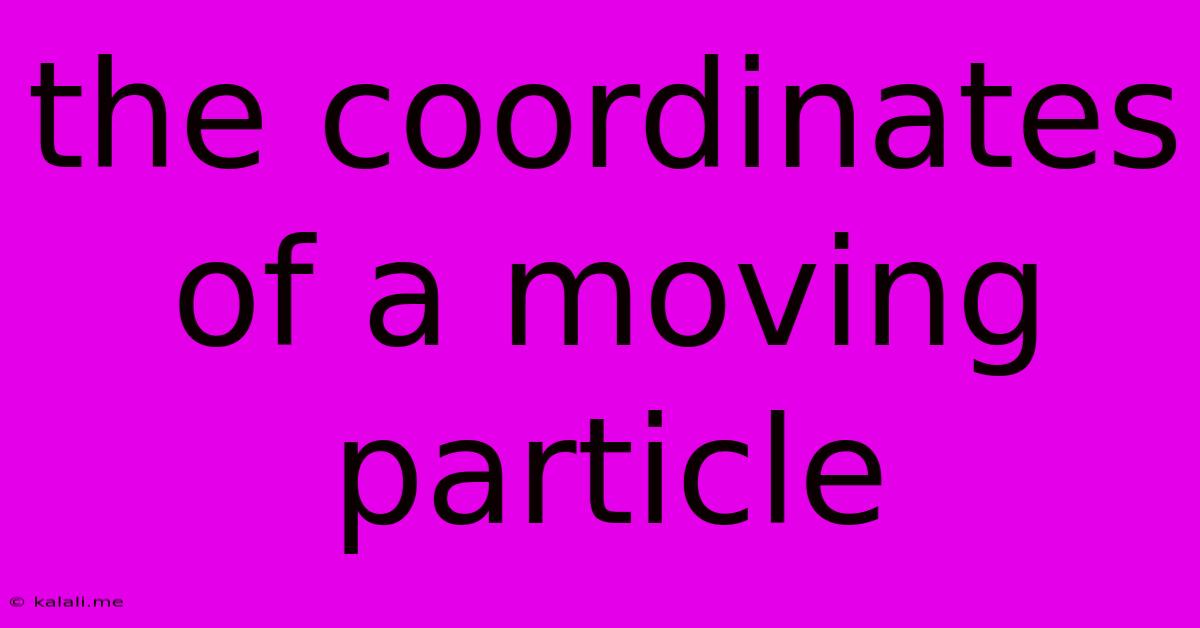The Coordinates Of A Moving Particle
Kalali
Jun 15, 2025 · 3 min read

Table of Contents
Tracking the Trajectory: Understanding the Coordinates of a Moving Particle
This article delves into the fascinating world of particle motion, explaining how we describe and track the changing coordinates of a moving particle. Understanding this is fundamental in various fields, from physics and engineering to computer graphics and game development. We'll explore different coordinate systems and how to express particle movement mathematically. This will include examining velocity and acceleration as derivatives of the position vector, and briefly touching upon more complex scenarios.
What are Coordinates and Why are They Important?
Coordinates are a set of values that uniquely specify the location of a point in space. In the simplest case, for a particle moving in two dimensions (like a bug crawling on a table), we use Cartesian coordinates (x, y). These represent the horizontal and vertical distances from a chosen origin point. For a particle moving in three dimensions (like a drone flying in the air), we add a third coordinate, z, representing the height. These coordinates are crucial because they allow us to precisely track the position of the particle at any given moment in time. Without a system to define location, understanding motion becomes impossible.
Describing Particle Motion with Vectors
To fully describe the motion of a particle, we use vectors. A position vector, denoted as r, represents the particle's location relative to the origin. In Cartesian coordinates:
r = xi + yj + zk
Where i, j, and k are the unit vectors along the x, y, and z axes respectively. The magnitude of this vector gives the distance from the origin.
Velocity and Acceleration: Derivatives of Position
The particle's motion isn't static; it changes with time. The velocity vector, v, describes the rate of change of the position vector with respect to time:
v = dr/dt = dx/dt i + dy/dt j + dz/dt k
This vector indicates both the speed and direction of the particle's movement. Similarly, the acceleration vector, a, describes the rate of change of velocity:
a = dv/dt = d²r/dt² = d²x/dt² i + d²y/dt² j + d²z/dt² k
This tells us how the particle's velocity is changing over time. Understanding velocity and acceleration is key to predicting future positions.
Beyond Cartesian Coordinates: Other Coordinate Systems
While Cartesian coordinates are widely used, other systems can be more suitable depending on the situation. For example, polar coordinates (r, θ) are useful for describing circular motion, while spherical coordinates (r, θ, φ) are ideal for situations involving three-dimensional spherical symmetry. The choice of coordinate system greatly impacts the complexity of the mathematical description of the particle's trajectory.
Complex Scenarios and Advanced Techniques
Tracking particles becomes significantly more challenging when dealing with factors like friction, air resistance, or multiple interacting particles. In such cases, numerical methods and computational techniques, such as finite element analysis or particle simulations, are often employed.
Conclusion
Defining and tracking the coordinates of a moving particle is a foundational concept across various scientific and engineering disciplines. Understanding how to represent its position using vectors, calculate its velocity and acceleration, and choose the appropriate coordinate system are essential skills for anyone working with moving objects. Whether you’re simulating a planetary orbit or designing a robotic arm, a firm grasp of these principles is crucial.
Latest Posts
Latest Posts
-
Which One Of The Following Is An Intensive Property
Jun 15, 2025
-
Radius Of The Moon In M
Jun 15, 2025
-
Which Of The Following Expressions Has A Value Of 4
Jun 15, 2025
-
What Does Xlv Mean In Roman Numbers
Jun 15, 2025
-
Ability Of A Material To Resist Deformation
Jun 15, 2025
Related Post
Thank you for visiting our website which covers about The Coordinates Of A Moving Particle . We hope the information provided has been useful to you. Feel free to contact us if you have any questions or need further assistance. See you next time and don't miss to bookmark.